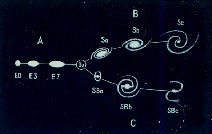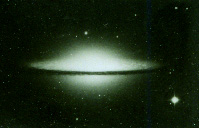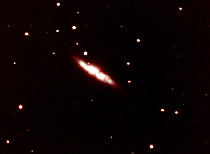Other Galaxies
Let's look at a larger collection of galaxies. In general, there are three
types of galaxies: spirals (like the Milky Way, Andromeda Galaxy, and
Pinwheel Galaxy), ellipticals and irregulars.
Here's the so-called Hubble tuning-fork diagram which illustrates
the classification of galaxies. Eliptical galaxies are classified as E0
through E7 depending on their roundness. Spiral galaxies are classified as
either spiral or barred spirals and are further subclassified according to
how tightly the spiral arms are wrapped around the nucleus of the galaxy.
 Located near the star Zeta Ursa Majoris (also called Mizar) is a fine
example of a spiral galaxy, M101 (NGC 5457).
Located near the star Zeta Ursa Majoris (also called Mizar) is a fine
example of a spiral galaxy, M101 (NGC 5457).
 It is about 15 million light years away and is about 90,000 light
years in diameter. This is 90% the size of the Milky Way, however M101 is
only about 10% as massive as the Milky Way.
Many galaxies are collected into groups called "galaxy clusters."
The nearest large cluster of galaxies to us is the Virgo Cluster.
The Virgo Cluster is located in this part of the sky [Point out Virgo, Coma
Bernecies boarder.] There have been 1000's of galaxies detected in this
region, all located at around 40 or 50 million light years distance.
Our local group of galaxies is drawn ("falling" if you like) towards the
Virgo Cluster at a few 100 km/sec.
It is about 15 million light years away and is about 90,000 light
years in diameter. This is 90% the size of the Milky Way, however M101 is
only about 10% as massive as the Milky Way.
Many galaxies are collected into groups called "galaxy clusters."
The nearest large cluster of galaxies to us is the Virgo Cluster.
The Virgo Cluster is located in this part of the sky [Point out Virgo, Coma
Bernecies boarder.] There have been 1000's of galaxies detected in this
region, all located at around 40 or 50 million light years distance.
Our local group of galaxies is drawn ("falling" if you like) towards the
Virgo Cluster at a few 100 km/sec.
One member of the Virgo Cluster is this galaxy, called the Sombrero Galaxy
(M104/NGC 4594).
 It is about
40 million light years away. It is seen edge-on and the dark band is due
to thick clouds of gas and dust which obsure the bright stars behind them.
It is about
40 million light years away. It is seen edge-on and the dark band is due
to thick clouds of gas and dust which obsure the bright stars behind them.
We have already seen an example of an elliptical galaxy. It is NGC 205,
one of the companion galaxies of the Andromeda Galaxy.

We have also, in fact, seen an example of an irregular galaxy in the Large
Magellanic Cloud. Another fine example is located about here in Ursa
Major. It is M82 (NGC 3034). Here's a photo.
 We see no regular structure. In fact, you can see dust
lanes similar to what we saw in the Sombrero Galaxy, only much less
organized. Some scientists theorize that M82 is undergoing an explosive
event, possibly triggered by galactic collisions. This galaxy is some 10's
of millions of light years away.
We see no regular structure. In fact, you can see dust
lanes similar to what we saw in the Sombrero Galaxy, only much less
organized. Some scientists theorize that M82 is undergoing an explosive
event, possibly triggered by galactic collisions. This galaxy is some 10's
of millions of light years away.
The Virgo Cluster is far from unique. Studies in the last 20 years have
revealed that most galaxies are contained in clusters. Here's a negative
photograph of a cluster of galaxies in Hercules.
 In turn, these clusters of galaxies are collected in
superclusters, which are themselves contained in supersuperclusters. On
the scale of billions of light years, the universe consists of sort-of
filaments of these clusters which stretch through space separated by large
voids which contain few to no galaxies.
In turn, these clusters of galaxies are collected in
superclusters, which are themselves contained in supersuperclusters. On
the scale of billions of light years, the universe consists of sort-of
filaments of these clusters which stretch through space separated by large
voids which contain few to no galaxies.
Go to next section.
Return to
"Planetarium Shows This Semester"






